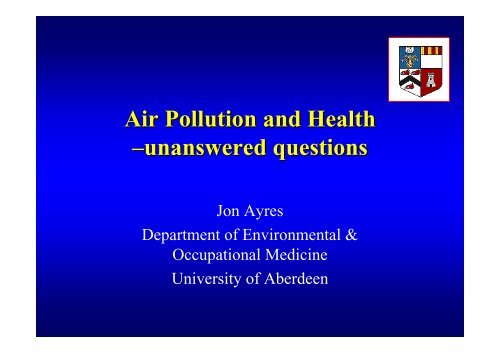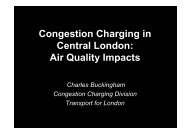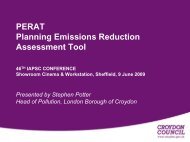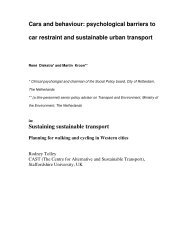Air Pollution and Health –unanswered questions - IAPSC
Air Pollution and Health –unanswered questions - IAPSC
Air Pollution and Health –unanswered questions - IAPSC
Create successful ePaper yourself
Turn your PDF publications into a flip-book with our unique Google optimized e-Paper software.
<strong>Air</strong> <strong>Pollution</strong> <strong>and</strong> <strong>Health</strong><br />
<strong>–unanswered</strong> <strong>questions</strong><br />
Jon Ayres<br />
Department of Environmental &<br />
Occupational Medicine<br />
University of Aberdeen
<strong>Air</strong> <strong>Pollution</strong> <strong>and</strong> <strong>Health</strong> <strong>–unanswered</strong><br />
<strong>questions</strong><br />
• What is the dose to the individual<br />
– susceptibility<br />
• Acute cardiac effects<br />
• Which particle metric<br />
• Chronic effects<br />
– Does air pollution cause asthma<br />
– How much life is lost<br />
• Interventions<br />
– Changes in emissions
Acute cardiac effects
<strong>Air</strong> pollution <strong>and</strong> cardiovascular mortality<br />
% increase /10 ìg/m 3 Increase in PM 10<br />
8<br />
Respiratory<br />
% Change in Daily Mortality<br />
6<br />
4<br />
2<br />
0<br />
-2<br />
Total<br />
Cardiovascular<br />
Santa Clara<br />
Philadelphia<br />
Utah Valey<br />
Birmingham<br />
Cincinnatti<br />
Six Cities<br />
Santa Clara<br />
Philadelphia<br />
Utah Valey<br />
Birmingham<br />
Cincinnatti<br />
Six Cities<br />
Santa Clara<br />
Philadelphia<br />
Utah Valey<br />
Birmingham<br />
Cincinnatti<br />
Six Cities
PM 10 <strong>and</strong> Cardiac Admissions<br />
• Daily hospital<br />
admissions of elderly<br />
(65+ yrs) for 1986-89<br />
(Detroit)<br />
• 32 ìg/m 3 (IQR)<br />
increase in PM 10<br />
associated with:<br />
+1.8% 1IHD<br />
+2.4% IHeart Failure<br />
+1.9% IDysrhythmias<br />
Admissions/Day<br />
Ischemic Heart Disease<br />
46<br />
45<br />
44<br />
43<br />
42<br />
0 25 50 75 100<br />
PM 10<br />
(m g/m 3 )<br />
Schwartz & Morris, Am J Epi 1995
<strong>Air</strong> <strong>Pollution</strong> <strong>and</strong> Arrhythmia<br />
PM 2.5 lag 2 days<br />
OR for ICD Discharge<br />
1.8<br />
1.6<br />
1.4<br />
1.2<br />
1.0<br />
0.8<br />
0 10 20 30<br />
PM 2.5<br />
(m g/m 3 )<br />
Peters et al 2000
<strong>Pollution</strong> Pollutant Exposure<br />
exposure<br />
Pulmonary<br />
Injury<br />
Effect on airway<br />
receptors<br />
Thrombosis <strong>and</strong><br />
inflammation<br />
Impairment of<br />
cardiac vagal<br />
control<br />
Plaque rupture<br />
<strong>and</strong> coronary<br />
occlusion<br />
Myocardial<br />
Ischaemia<br />
CVS<br />
Death
Cardiac effects - what we don’t (fully)<br />
know<br />
• The susceptible sub-groups<br />
• How these effects occur (mechanisms)<br />
• The degree of loss of life
Which particle metric<br />
• PM 2.5<br />
• PM 10<br />
• Numbers<br />
– surface area<br />
– surface constituents<br />
• NO 2
Chronic effects
Asthma <strong>and</strong> air pollution<br />
• Does air pollution make asthma worse on<br />
a day-to-day basis<br />
• Does air pollution make asthma worse<br />
over time<br />
• Does air pollution cause asthma in the<br />
first place
Asthma <strong>and</strong> air pollution in Children of 12<br />
communities of Southern California<br />
(McConnell et al 2002)<br />
• Asthma incidence: increased in high ozone<br />
areas (median 8-hr 57ppb) among children<br />
playing three or more outdoor sports (8% of<br />
all children)<br />
• Asthma prevalence: no association<br />
• Asthma incidence: no association
Prevalence of Asthma symptoms <strong>and</strong> proximity<br />
to traffic. 60,000 children in Nottingham UK.<br />
Venn et al 2000<br />
Primary schools<br />
Secondary schools
ISAAC UK: prevalence of wheezing in urban <strong>and</strong><br />
non urban children aged 12-14 yrs. N= 27,000.<br />
Kaur et al 1998<br />
Urban<br />
Non Urban<br />
60<br />
50<br />
Percentage<br />
40<br />
30<br />
20<br />
10<br />
0<br />
Ever<br />
wheezed<br />
Wheeze<br />
past 12<br />
months<br />
>4<br />
episodes<br />
Daily<br />
activities<br />
affected<br />
Speech<br />
limiting<br />
attacks
Asthma <strong>and</strong> air pollution<br />
• Does air pollution make asthma worse on<br />
a day-to-day basis - YES<br />
• Does air pollution make asthma worse<br />
over time – DON’T KNOW<br />
• Does air pollution cause asthma in the<br />
first place – PROBABLY NOT
Life expectancy <strong>and</strong> chronic effects of air<br />
pollution -<br />
estimated effect of reducing PM 2.5 by 1ìg/m 3<br />
COMEAP 2001.<br />
• On average around 2.5d/person/lifetime<br />
– ca. 0.35m life years for the whole UK population<br />
• But if this applies only to a susceptible proportion the<br />
improvement would be greater<br />
– if 10% population susceptible would amount to around 1 month<br />
per susceptible person<br />
– if 1% susceptible would amount to around 1 year per person<br />
• For a birth cohort born in 2000 the average individual<br />
benefit would be between 0.5 <strong>and</strong> 4.5 weeks
Chronic effects – what we don’t know<br />
• Whether all the population is at risk from air<br />
pollution exposure<br />
• In those who are susceptible to what extent they<br />
are affected<br />
– Loss of life<br />
– Worsening disease<br />
• Whether air pollution causes asthma<br />
• What the cost-benefits would be of reducing air<br />
pollution, in health terms
Interventions
Changes in pollutants <strong>and</strong> mortality in<br />
Dublin – 1984-97<br />
Clancy et al Lancet 2002;360:1210-4]
Changes in pollutants <strong>and</strong> mortality in<br />
Dublin – 1984-97<br />
• 35.6ìg/m 3 (70%) decline in black smoke<br />
• Adjusted non-trauma deaths fell by 5.7%<br />
• Respiratory deaths fell by 15.5%<br />
• Cardiovascular deaths fell by 10.3%<br />
• This represents about 116 fewer respiratory <strong>and</strong><br />
243 cardiovascular deaths pa<br />
Clancy et al Lancet 2002;360:1210-4]
Cardiorespiratory <strong>and</strong> all cause changes in<br />
mortality after reduced sulphur emissions in<br />
Hong Kong<br />
• 2.1% fall in all cause deaths<br />
• 3.9% fall in respiratory deaths<br />
• 2.0% fall in cardiovascular deaths<br />
• Mostly occurring in the first 2 years post intervention<br />
• Average gain in life expectancy per year of exposure was<br />
20 days (f) <strong>and</strong> 40 days (m)<br />
• More recently, suggested this could be due to changes in<br />
health care delivery over the same period<br />
Hedley et al Lancet 2002;360:1646-52]
<strong>Air</strong> <strong>Pollution</strong> <strong>and</strong> <strong>Health</strong> <strong>–unanswered</strong><br />
<strong>questions</strong><br />
• Cardiac effects<br />
– Who are the susceptible sub-groups<br />
– How do these effects occur (mechanisms)<br />
• Chronic effects<br />
– Is all the population at risk from air pollution<br />
– What is the size of the effect<br />
– Does air pollution cause asthma<br />
– What would the cost-benefits be of reducing air<br />
pollution, in health terms<br />
• Interventions<br />
– Are they of short or long term benefit or both<br />
– What pollutants should be targeted










